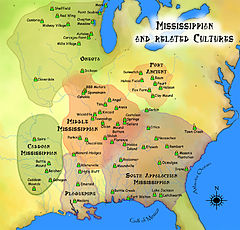- Chisca
-
Chisca Total population Extinct as a tribe Regions with significant populations Tennessee and Virginia  United States
United StatesLanguages linguistic affiliation uncertain
Religion Indigenous religion
Related ethnic groups The Chisca were a tribe of Native Americans living in eastern Tennessee and southwestern Virginia in the 16th century. They were encountered by both the Hernando de Soto Expedition in 1542 and the Captain Juan Pardo Expedition in 1568. De Soto sent out a small exploration party in the vicinity of the upper Tennessee River, who were attacked and defeated by Chisca warriors.[1] The experience convinced de Soto to limit explorations in Chisca territory.
Captain Juan Pardo also sent exploration parties that fought with the Chisca (Pardo called them Chisca; his chronicler called them Uchi). His men destroyed their settlement at Maniatique, thought to be at present-day Saltville, Virginia.[2] The name Chisca seldom appeared in Spanish colonial records after the 16th century.
In 1683 the French explorer La Salle found a Cisca village between the Cumberland and Tennessee rivers (in Yuchi territory, now northern Tennessee). He persuaded them and the Shawnee north of the Cumberland to relocate to Fort St. Louis in Illinois and live under French protection. Around this time, these Cisca seem to have joined with the Shawnee under the name Chaskepe. They followed the Shawnee's later migrations (1692–1754) through Virginia, Maryland, Pennsylvania and finally Ohio. La Salle reported that the Cisca had originally lived in the Appalachians east of where he found them, until their town was burnt down by colonists from Florida (he mistakenly called those people English; they were Spanish).[3] The Chisca appeared to have become extinct as a tribe by the 18th century.
Contents
Notes
- ^ Hudson, Knights of Spain, Warriors of the Sun, 203
- ^ See Robin Beck, "From Joara to Chiaha: Spanish Exploration of the Appalachian Summit Area, 1540-1568", Southeastern Archaeology 16(2) Winter 1997, for a full scholarly discussion of the location of Maniatique.
- ^ Charles Augustus Hanna, 1911 The Wilderness Trail, Vol II, 1911, pp. 93-95.
See also
References
- Beck, Robin, "From Joara to Chiaha: Spanish Exploration of the Appalachian Summit Area, 1540-1568", Southeastern Archaeology, 16(2) Winter 1997
- Hudson, Charles, The Southeastern Indians, Knoxville,TN: University of Tennessee Press, 1976.
- Hudson, Charles, Knights of Spain, Warriors of the Sun, Athens, GA: University of Georgia Press, 1997.
- Swanton, John R. The Indian Tribes of North America, Washington, DC: Smithsonian Institution Press, 1952.
- Thornton, Richard, Ancient Roots I: The Indigenous People of the Southern Highlands, Morris, NC: Lulu Press, 2007.
Worth, John E. (2004). "Chisca". In Raymond D. Fogelson, ed.. Handbook of North American Indians, Vol. 14: Southeast. Washington, D.C.: Smithsonian Institution. pp. 176–77 [unified volume Bibliography, 772–999].
External links
 Pre-Columbian North America
Pre-Columbian North AmericaArchaeological cultures North American pre-Columbian chronology – Adena – Alachua – Ancient Pueblo (Anasazi) – Baytown – Belle Glade – Buttermilk Creek Complex – Caborn-Welborn – Calf Creek – Caloosahatchee – Clovis – Coles Creek – Deptford – Folsom – Fort Ancient – Fort Walton – Fremont – Glades – Glacial Kame – Hopewell (List of Hopewell sites) – Hohokam – Leon-Jefferson – Mississippian (List of Mississippian sites) – Mogollon – Monongahela – Old Cordilleran – Oneota – Paleo-Arctic – Paleo-Indians – Patayan – Plano – Plaquemine – Poverty Point – Prehistoric Southwest – Red Ocher – Santa Rosa-Swift Creek – St. Johns – Steed-Kisker – Tchefuncte – Tocobaga – Troyville
Archaeological sites Angel Mounds – Bandelier National Monument – The Bluff Point Stoneworks – Cahokia – Chaco Canyon – Casa Grande – Coso Rock Art District – Eaker – Effigy Mounds National Monument – Etowah Indian Mounds – Eva – Folsom Site – Fort Ancient – Fort Center – Gila Cliff Dwellings National Monument – Holly Bluff Site – Hopewell Culture National Historical Park – Kincaid Mounds – Kolomoki – Manitou Cliff Dwellings – Marksville – Meadowcroft Rockshelter – Mesa Verde – Moorehead Circle – Moundville – Mummy Cave – Nodena Site – Ocmulgee National Monument – Old Stone Fort – Parkin Park – Pinson Mounds – Portsmouth Earthworks – Poverty Point – Pueblo Bonito – Rock Eagle – Rock Hawk – Salmon Ruins – Serpent Mound – Spiro Mounds – SunWatch – Taos Pueblo – Toltec Mounds – Town Creek Indian Mound – WintervilleMiscellaneous Ballgame – Black drink – Buhl woman – Calumet – Chunkey – Clovis point – Container Revolution – Eastern Agricultural Complex – Eden point – Effigy mound – Falcon dancer – Folsom point – Green Corn Ceremony – Horned Serpent – Kennewick man – Kiva – Metallurgy – Mi'kmaq hieroglyphic writing – Medicine wheel – Mound builders – N.A.G.P.R.A. – Norse colonization of the Americas – Piasa – Pueblo dwellings – Southeastern Ceremonial Complex – Three Sisters agriculture – Thunderbird – Underwater panther
Categories:- South Appalachian Mississippian culture
- Native American history of Tennessee
- Native American history of Virginia
- Appalachian culture
- Native American tribes in Virginia
- Native American tribes in Tennessee
- Pre-state history of Tennessee
- History of Spain
- Spanish colonization of the Americas
Wikimedia Foundation. 2010.


